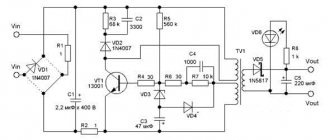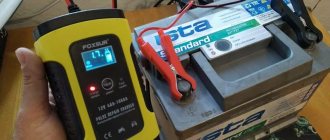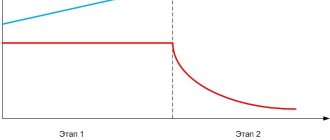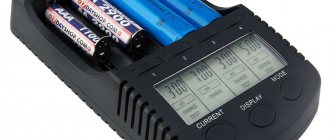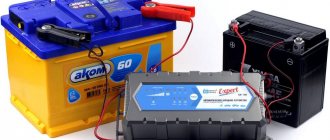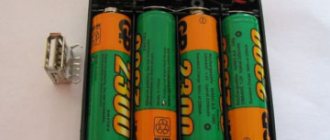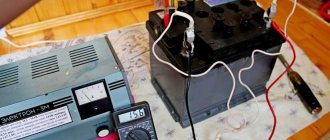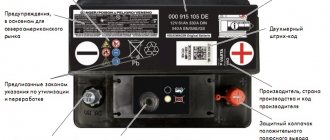Modern devices can operate not only from the mains, but also autonomously. For this purpose, a battery is used, which stores energy through a charger. Types of chargers and their features depend on the type of electrical appliances and the features of power supply. There are chargers for both home and industrial use.
Chargers are used to power the device's battery.
Types of chargers.
There are a large number of devices on the charger market, the functionality of which allows you to do much more than just supply direct current to the battery terminals. If we consider the topic of memory types globally, they are divided into transformer and pulse. At the moment, transformer ones are already on their way out, giving way to more modern models.
Almost all types of chargers that currently exist are inverter. The main difference between such devices is that they are charged by pulses rather than by direct current. They have a built-in electrical board that allows you to control a stable charging process. The advantages of pulse chargers include light weight, compact dimensions and ease of operation.
Let's look at the main types of chargers:
- Start-up chargers (ROM) are one of the most popular types of automatic chargers, which are used mainly at service stations. Suitable for batteries of different parameters and power. Ideal in a situation where for some reason you cannot remove the battery and connect it to charge. The ROM prepares the battery for starting as quickly as possible and gives a reserve of time.
- Charging and recovery batteries are the best option for charging your home car. During discharging, the lead plates are in the process of sulfonation, and during the minutes of recharging, various active substances are formed. The level of coating of the plates with sulfate crystals depends on the conditions of use. With good care, it remains low, and a large percentage of the crystals evaporate when the charge is restored. But if conditions are unfavorable, the plates become coated with large sulfate particles that do not disappear during charging, and power is lost on the working surface. With the help of a charging-reducing device, desulfation occurs.
- Equalizing chargers are a type of charger used in situations where two batteries connected in series are used to achieve a 24 V DC circuit. According to the rules for charging several batteries, all characteristics and charge levels must be the same. This approach eliminates overcharging of one battery and incomplete charging of another. If there is a difference in charge, the batteries will be irreparably damaged. To avoid such a situation, an equalizing charger is used, which works quite simply: the device transfers charge from a battery with a higher voltage to a battery with a lower one. When the charge on the two batteries is equalized, the device stops working. Thanks to this device, it is possible to extend the service life of batteries operating in combination.
There is another category of chargers - portable chargers for a car battery, designed to start the engine when the battery is dead, away from the electrical network.
Voltage supplied by the charger
There are three common types of batteries - 6-volt, 12-volt and 24-volt. 6-volt batteries are used on motorcycles with low on-board voltage. 12-volt ones are installed on cars, and 24-volt ones on buses, trucks, and tractors. Therefore, you should choose a charger that operates in the desired voltage range.
The voltage supplied by the charger must ensure the process of capacity restoration. In the case of 12 V, you should set 13.8–14.4 V on the charger to charge to a level of 75–85%. This value is provided by the car's generator. When set to 15 V, the charge level increases to 85–90%, and at 16.3 V to 95–97%.
How to choose a battery charger?
Before purchasing a charger, decide on the following indicators and additional functions of the device.
Automatic or not?
There is no single opinion on which battery charger to choose. If you know the maintenance technology perfectly, devices with manual control or external control via Wi-Fi will suit you. If you are a beginner, then there are options for you with automatic selection of current and voltage.
Take into account a few tips:
- the machine is only suitable for monthly recharging of a battery discharged to a maximum of 50%;
- Buy expensive programmable devices with a recovery function only for group use;
- if in the future you plan to study batteries in more detail, it makes sense to purchase automatic microprocessor devices with a programming function.
Operating modes.
There are two modes of operation of the charger - current stabilization and voltage stabilization:
- In the first case, the battery charges faster, but in order to prevent damage to it, the charging current is slightly reduced at the end of charging.
- In the second case, the battery current changes during charging, while the charging voltage remains constant. When the charging process ends, the current gradually decreases.
In addition to regular charging, devices may also have a Boost mode for fast charging. It provides increased current for fast charging, which is enough to start the engine. The battery in this mode can be charged in 15 minutes, but using this mode is often not recommended.
There are also professional devices on sale that are designed to charge several batteries at once when connected in parallel or in series.
Current strength.
The compatibility of the charger with the battery itself depends on the strength of the charging and starting current. This parameter is measured in amperes and is determined through the nominal capacity of the battery. If the charging current can be adjusted, consider the highest value in the same way as the starting current:
- Charging current strength. The optimal value will be 10 times less than the nominal capacity of the car battery - for an 80 Ah battery, a charger with a charging current of 8 A is suitable. A charging current that is too small will increase the charging duration, although it has a positive effect on the service life; too large will allow you to charge the battery much faster , but shortens its service life.
- Starting current strength. The optimal value exceeds the nominal capacity of the battery by 10 times, so for an 80 Ah battery you will need charging with a starting current of 800 A.
Do not use charging if the starting current of the machine exceeds the starting current of the device, as it begins to work at the limit of its capabilities, which can lead to breakdown and even fire. Select a charger with a reserve of 10-15% in starting current, as this protects against risks and allows you to charge a battery with a large capacity.
Voltage.
Modern chargers are rarely limited to a clearly defined voltage rating, but you should know that a charger with a voltage of 12 V is suitable for a car battery.
There are also 6 V and 24 V models on sale. The former are needed for charging motorcycle batteries, and the latter for trucks.
There are also models with a 12/24 or 6/12/24 operating mode switch. However, most motorists will not need these, so there is no point in overpaying for extra functionality.
Desulfation mode.
This is a useful feature of chargers. Sometimes, due to bad weather or after deep discharges, sulfuric acid sulfates form on the battery plates, and the density of the electrolytes decreases, which is why their capacity decreases (sometimes up to 70-80% loss).
To restore these values, the desulfation mode is used - special charge-discharge cycles. Place the battery on charge and the charger in desulfation mode and leave it like that for several days. In the process, sulfates are destroyed, the plates are cleaned, and the battery capacity is restored.
Protection and safety.
Types of protection that should be included in the car charger:
- overcharge protection is the main one, since if the battery is overcharged, it instantly fails;
- temperature control is necessary to turn off the charging process when the battery plates heat up, which leads to their destruction;
- Short circuit protection is necessary in the event of a short circuit in the battery banks.
Power consumption.
When choosing a charger, pay attention to its power - the process of charging with a low-power device requires a lot of time and the device is working at its limit. The power reserve must be at least 15%.
To calculate the time required to charge the battery, divide the capacity of the battery by the charging current, then add another 10% to the resulting values - multiply by 1.1. For example, to charge a battery with a capacity of 50 Ah with a charger with a current of 10 A, it will take 50/10 * 1.1 = 5.5 hours. And to charge a 90 Ah battery with the same device will take almost 10 hours.
Battery capacity.
These are not physical dimensions, but a value measured in units of Amperes per hour, which determines the amount of current supplied to the battery over a certain time:
- The capacity of the battery being charged is one of the parameters by which the compatibility of the charger and battery is determined. Modern devices are designed for a wide range of battery capacities, which greatly simplifies the selection of a suitable unit (45-120 Ah, 33-180 Ah). The battery and charger must match this indicator. If the discrepancies are too large, this causes premature wear of both devices.
- Capacity of the built-in battery. The larger it is, the longer the charger will work and the more functions it will implement. As the capacity of the built-in battery increases, the cost and weight of the device increases. The built-in battery allows you to provide starting current in the absence of a stationary power supply, and also powers additional devices.
Select the battery capacity as follows:
- with an engine capacity of 1-1.6 liters, a battery with a capacity of 55 Ah is suitable;
- 1.3-1.9 l - 60 Ah;
- 1.4-2.3 l - 66 Ah;
- 1.6-2.3 l - 77 Ah;
- 1.9-4.5 l - 90 Ah;
- 3.8-10.9 l - 140 Ah;
- 7.2-12 l - 190 Ah;
- 7.5 - 17 l - 200 Ah.
Temperature Range.
Most modern batteries operate over a wide temperature range. But keep in mind that at very low and very high temperatures the chemical structure of the battery can change, which causes big problems.
Charging batteries at high and low temperatures:
| Battery Type | Charge temperature | Discharge temperature |
| Lead-acid | from -20 to +50 | from -20 to +50 |
| NiCd, NiMH | from 0 to +45 | from -20 to +65 |
| Lithium-ion | from 0 to +45 | from -20 to +60 |
To avoid problems, it is recommended to place the battery in acceptable temperature conditions before charging. The optimal temperature for charging is considered to be from +10 to +30 degrees, but you can charge at other temperatures:
- A lead-acid battery is charged at temperatures from -20 to +50, but if charging occurs at subzero temperatures, the current is reduced to 0.3 A or lower.
- If the battery is nickel-cadmium or nickel-metal hydride, charge it at a temperature from 0 to +45 degrees. When charging in the range from 0 to +5 degrees, the current is reduced to 0.3 A, otherwise the efficiency of the device is seriously reduced.
- If the battery is lithium-ion, charge it at temperatures from 0 to +45 degrees. At subzero temperatures, charging the battery is prohibited to avoid damaging it.
Manufacturer.
The modern market offers both domestic developments and products of world leaders. Among the most popular manufacturers among Russian drivers are the following:
- Aiken company produces a wide range of electrical devices, including devices for charging car batteries.
- The well-known Italian manufacturer of welding machines and chargers Telwin offers high quality products. They have simple devices priced at 2,500-2,700 rubles, but for professional use, purchase models for 11-13.5 thousand rubles.
- The Russian company Caliber produces several devices for charging batteries. The ZU-100 option (cost 1,700-1,800 rubles) is suitable for amateurs, and the PZU-2.0/12.0S modification will be of interest to car service workers. The price is 6.5-6.6 thousand rubles.
- Resanta chargers are equipped with a battery, so you can start the engine far from a source of electricity. The price of PU series models is from 2,300 rubles. Some variations are more expensive due to the presence of a flashlight, compressor and USB connector.
- Inexpensive chargers are offered by Sorokin . Model 12.92 has a low current strength and a price of 970-1,000 rubles.
Control devices.
Professionals prefer devices with a voltmeter and an ammeter, as they are more informative. When you see the values, it becomes clear at what stage the charging is currently at. For example, if the current values drop below 1 A, then the charging process is over.
The ampere-hour indicator is of particular value - if you monitor the actual capacity, you can complete desulfation and recharging in time.
The presence of additional indicators should also not be underestimated:
- “charging is impossible” helps determine whether everything is okay with the device itself, since the market is flooded with low-quality devices;
- “reversal” - not everyone pays attention to clamps mixed up in a hurry, but this indicator helps to understand the reason for the denial of service.
Chargers also have the following useful features:
- charge retention test;
- work as a power supply;
- spark warnings;
- short circuit protection.
Dimensions and weight.
Chargers for car batteries are mostly of medium size, which differ depending on the type of device. For example, transformer chargers are large in size and weight (one such device weighs up to several kilograms), which makes them bulky and inconvenient. But pulse ones, on the contrary, weigh only half a kilogram, making them very convenient to transport.
Pros and cons of each type
Advantages of the charger and pre-start device:
- low weight and dimensions.
- fully automatic operating mode.
- autonomy (not for all devices).
Some models are “power banks,” that is, batteries for batteries. They do not need to be plugged into an outlet at all; you can carry them with you in the trunk for an emergency. But such models are rare; most are still “socket-type”.
Automatic operation means the “set it and forget it” principle. You can choose a model with the required number of manual settings to suit your own taste - there are fully automatic ones, with a single “on-off” button, and there are others equipped with manual current and voltage regulators.
Such devices have only one drawback: they are not able to restore the charge in the battery, which has dropped to zero (for example, when stored in an unheated room in winter). Or they will charge a “zeroed” battery for a long time, about a day, depending on their own power and its capacity.
Charger-pre-start devices can help if the voltage level at the battery terminals has dropped by no more than 50-60%.
That is, for example, if the “battery” of a passenger car, which should produce 13 V, produces 6-7 V.
Advantages of charging and starting units:
- possibility of emergency starting of a car with a “zeroed” battery.
- the ability to fully charge a battery whose capacity has dropped to zero.
- the ability to work in recharging mode, like simpler devices.
- the required level of automation - a fully automatic device or with manual settings - the car owner can choose himself.
Disadvantages of these devices:
- significant dimensions and weight.
- increased cost.
- difficulty in setting up (not for all devices).
- they operate only from a household or industrial network.
Operating rules.
Any charger requires at least minimal care and compliance with basic operating rules. If the approach to the device is correct, even those made in China will work for a long time.
Basic recommendations for using the charger are as follows:
- Before turning on, inspect all ventilation openings, as they prevent the charger from overheating;
- check that the current parameters in the garage network correspond to the technical characteristics of the charger;
- clean the battery leads and terminals of the device;
- When connecting the charger to the battery, observe the polarity: connect the positive wire to the “+” terminal of the battery, and attach the negative terminal to the “-” terminal;
- do not disconnect the charger terminals from the battery terminals during charging;
- do not start the car engine while charging;
- after fully charging, first turn off the charger, and only then disconnect the wires;
- Store the device in a place inaccessible to dust, dirt and moisture.
Where can I purchase the device?
Once you have learned all the criteria by which you choose a charger, feel free to proceed to the purchase step. You can buy chargers or starting chargers both in regular stores that sell components for cars, and in online stores.
Many chargers for car batteries can be purchased from our Chinese friends on this website - https://ali.pub/40kig6
As you can see, they have everything from the simplest battery chargers to smart chargers with desulfation mode.
You can create a charger with your own hands, but it is better to have certain skills for this so as not to subsequently damage the car’s battery.
Desulfation function
It happens that due to weather conditions or deep discharge, sulfur sulfates appear on the battery plates, and the electrolyte density decreases along with the capacity. To restore normal parameters, you need to activate the desulfation mode - special charging and discharging cycles. It will ensure the destruction of sulfate elements, cleaning of the plates, and restoration of the capacitance indicator.
What does the price depend on?
Answering the question of exactly how much a good charger costs is quite problematic, because their price directly depends on the technical characteristics, functionality and even the image of the brand that this device produces.
The more bells and whistles a charger has, the more expensive it is. For example, on the market you can find models of both low price categories (from 900 rubles) and quite high ones (from 28 thousand rubles). It is important to find a balance between price and quality here.
Difficult choice
The above was only a small part of the models and manufacturers of chargers that are present on the market. In fact, there are many more memory models and an inexperienced buyer can easily get lost in them. If we discard all the technical details, then you can choose as follows.
If you periodically need a charger (you haven’t driven for a long time, the battery runs out in the cold season, etc.), then take an inexpensive model without unnecessary bells and whistles. It’s better to take a simple, functional device without adjustments or switches.
Experienced car owners who like to control the charging process can purchase a functional charger with a built-in ammeter, charging current control function and other advanced options.
For owners of AGM and GEL batteries, you should definitely ask whether the charger has functionality for charging such batteries.
Review of popular models.
To make it easier for you to purchase a charger for a car battery, we will tell you about the TOP 5 most reliable and functional chargers.
Aurora Sprint - 6
Aurora chargers will make your life much easier, since all you have to do is turn on the device and connect the crocodile clips, and the built-in microprocessor will do the rest. The device itself controls the process and protects the battery from increased current.
Advantages of this memory:
- microprocessor control;
- fully automatic charging;
- several degrees of protection - from polarity reversal, from overcurrent, thermal protection, from sparks, from overcharging;
- high charging efficiency.
Devices of this brand are able to work with any type of battery - both with serviced lead-acid and maintenance-free batteries with gel or solid electrolyte. The smart device is capable of resuscitating heavily discharged batteries with a voltage of 1.5 V or more. If the battery produces a lower voltage, the device detects the battery as non-working.
The characteristics are presented in the table:
| Indicators | Values |
| Power consumption | 100 W |
| Minimum charging current | 3 A |
| Maximum charging current | 6 A |
| Battery capacity | 7-240 Ah |
| Voltage | 6-12 V |
| Charging mode | Auto |
| Weight | 1.1 kg |
| Features and Features | Charging indicator, overcharge protection |
| Price | 3,100 rubles |
Bosch C3
The device is from a German manufacturer. It is a universal model for both acid and gel batteries. Thanks to the light indication, you can track batteries with a capacity of up to 200 Ah. It has such advantages as ease of use and the ability to charge after the battery is completely discharged.
You can find the technical characteristics of the charger in the table :
| Indicators | Values |
| Power consumption | 60 W |
| Minimum charging current | 0.8 A |
| Maximum charging current | 3.8 A |
| Battery capacity | 1.2-120 Ah |
| Voltage | 6-12 V |
| Charging mode | Auto |
| Weight | 1.3 kg |
| Type | Pulse |
| Features and Features | Protection against overheating, short circuit, overcharging, desulfation function available |
| Dimensions | 185*55*81 |
| Price | 3,800 rubles |
Kedr-auto-10
The device was developed in 2008, replacing its predecessor Kedr-auto-4. Designed for charging batteries based on acid electrolyte and lead plates. Compared to the previous version, Kedr-auto-10 has a number of advantages:
- high degree of protection against incorrect connection, overload and short circuit;
- there is a pre-start mode;
- the model is equipped with modern transformers;
- After charging is complete, the device automatically switches to recharging mode.
The characteristics of the memory are given in the table:
| Indicators | Values |
| Power consumption | 250 W |
| Minimum charging current | 5 A |
| Maximum charging current | 10 A |
| Battery capacity | 60 Ah |
| Voltage | 12 V |
| Charging mode | Auto |
| Weight | 0.6 kg |
| Features and Features | Protection against short circuit, overcharge and misconnection |
| Dimensions | 185*130*90 |
| Country of origin | Russia |
| Price | 1,750 rubles |
Orion PW-150
The Orion pulse charger itself monitors the state of charge of the battery and promptly changes the charging mode. Pointer or diode indicators allow you to monitor the strength of the charging current during the charging process and the health of the charging circuit.
Device Features:
- all Orion chargers have an internal temperature control circuit;
- it is possible to use the device as a pre-start device;
- can charge batteries with any degree of discharge.
characteristics table :
| Indicators | Values |
| Minimum charging current | 0.4 A |
| Maximum charging current | 5.5 A |
| Battery capacity | 45-65 Ah |
| Voltage | 12 V |
| Charging mode | Auto |
| Weight | 0.75 kg |
| Features and Features | Protection against short circuit, overcharging, incorrect connection |
| Dimensions | 200*155*85 |
| Type | Pulse |
| Country of origin | Russia |
| Price | 1,200 rubles |
Caliber UZ-20A
This charger is capable of working with 12- and 24-volt batteries. Charges small capacity batteries without problems. Cooling occurs due to the well-developed perforation of the case and a built-in fan for operation at high currents, and an overheating indicator is also provided. The body itself is metal.
The disadvantages include the ammeter - the scale is crude and uninformative.
Charger Specifications
| Indicators | Values |
| Power consumption | 220 W |
| Minimum charging current | 3 A |
| Maximum charging current | 20 A |
| Battery capacity | 10-130 Ah |
| Voltage | 12-24 V |
| Weight | 2 kg |
| Features and Features | Ammeter, charging indicator |
| Dimensions | 240*180*115 |
| Country of origin | China |
| Price | 2,900 rubles |
To learn how to choose a charger for a car battery, watch the following video:
Due to the abundance of chargers, it is very difficult to make the right choice - there are domestic and imported models on the market, and there are many fakes. To make your choice easier, decide how often you plan to use the charger, and if not often, your best option would be an inexpensive automatic charger without additional features.
I hope that the article was useful to you. If you want to supplement it or have any questions, write comments.
Best regards, administrator
Operating modes
Chargers can be automatic or manually operated. When purchasing an automatic device, the user only has to connect the wires and wait for the process to complete. The operating principle of many “automatic machines” involves supplying a stable current, which changes to a small current at a fixed voltage value.
Manually controlled devices require manual setting of the main parameters. And some devices have a programming function that should charge based on the established algorithm.
There are automatic models on the market that allow you to set a programmable mode. But you can buy them at a high price.
In addition to the main mode, a desulfation mode is known, characterized by a charge-discharge cycle to remove sulfate deposits. These deposits are released due to deep discharges or high air temperatures. The salts begin to seal the battery plates, resulting in reduced capacity. When the desulfation mode is turned on, a cycle occurs:
- supplying a charge with a current of 0.1 A for 5 seconds;
- discharge with a current of 0.01 A for 10 seconds.
The cycle is repeated until the voltage stabilizes at 14.6 V. Then the battery is charged in the usual way.
There is also a mode for checking performance and monitoring capacity. The latest chargers are designed to determine the performance of maintenance-free batteries. When the function is enabled, all “cans” are analyzed. After which the system shows the closed element.
Capacity monitoring provides calculation of the amount of current that the battery has drawn over a certain period of time.
